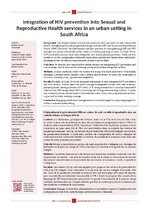Integration of HIV prevention into sexual and reproductive health services in an urban setting in South Africa
Abstract
Background: The United Nations Political Declaration on HIV and AIDS of 2006 stressed the
need to strengthen policy and programme linkages between HIV and Sexual and Reproductive
Health (SRH). However, the effectiveness and best practices for strengthening SRH and HIV
linkages are poorly researched in the context of family-planning services. In Cape Town,
HIV-prevention services have been integrated into family-planning services. There are two
models of service configuration: dedicated stand-alone reproductive health clinics and familyplanning
services located in comprehensive primary-care facilities.
Objective: To describe how reproductive health services are integrating HIV prevention and
care strategies and to measure the coverage and quality of these integrated services.
Methods: A cross-sectional study was conducted using structured interviews with facility
managers; a facility-based checklist; and a patient record review to assess the availability of
resources, training, access, quality and integration.
Results: Facilities in Cape Town are equipped adequately to offer integrated HIV-prevention
and SRH services. Overall there was poor coverage of integrated services with 54% of familyplanning
clients having a known HIV status; 47% being screened for a sexually transmitted
infection and 55% being offered HIV counselling and testing and receiving condoms. Quality
and continuity of care seemed better at the dedicated clinics than at the comprehensive facilities,
supported by better training coverage.
Conclusion: Engaging middle-level management is crucial with regard to improving integration
within a well-resourced setting.

